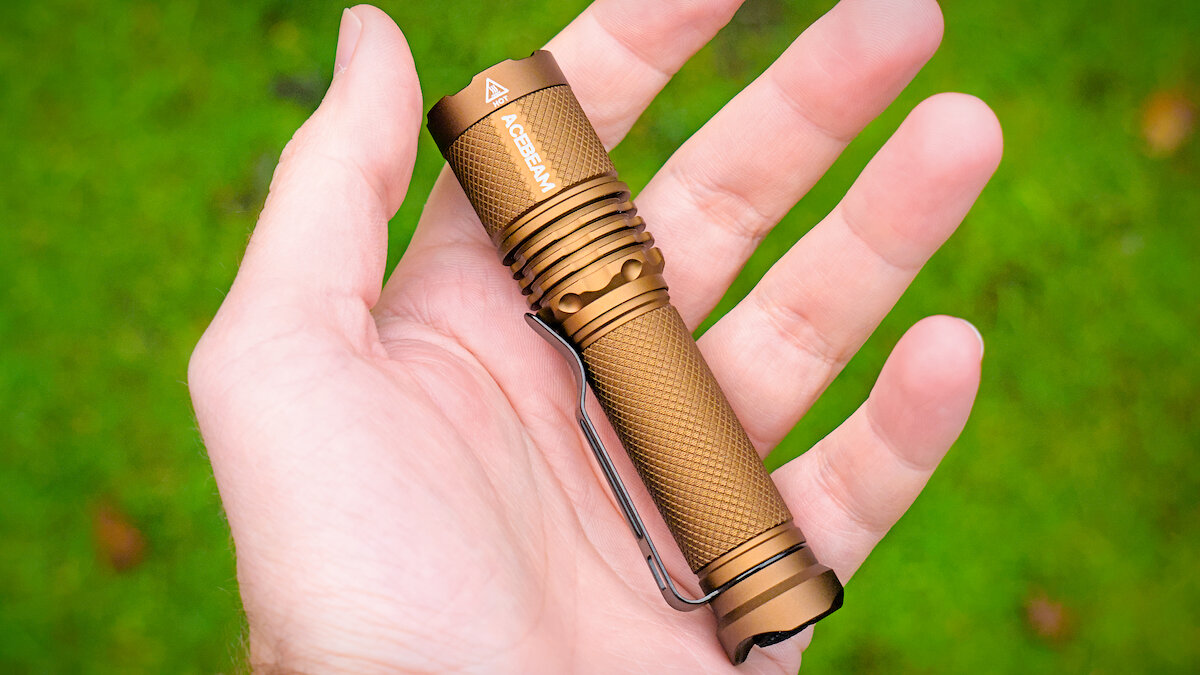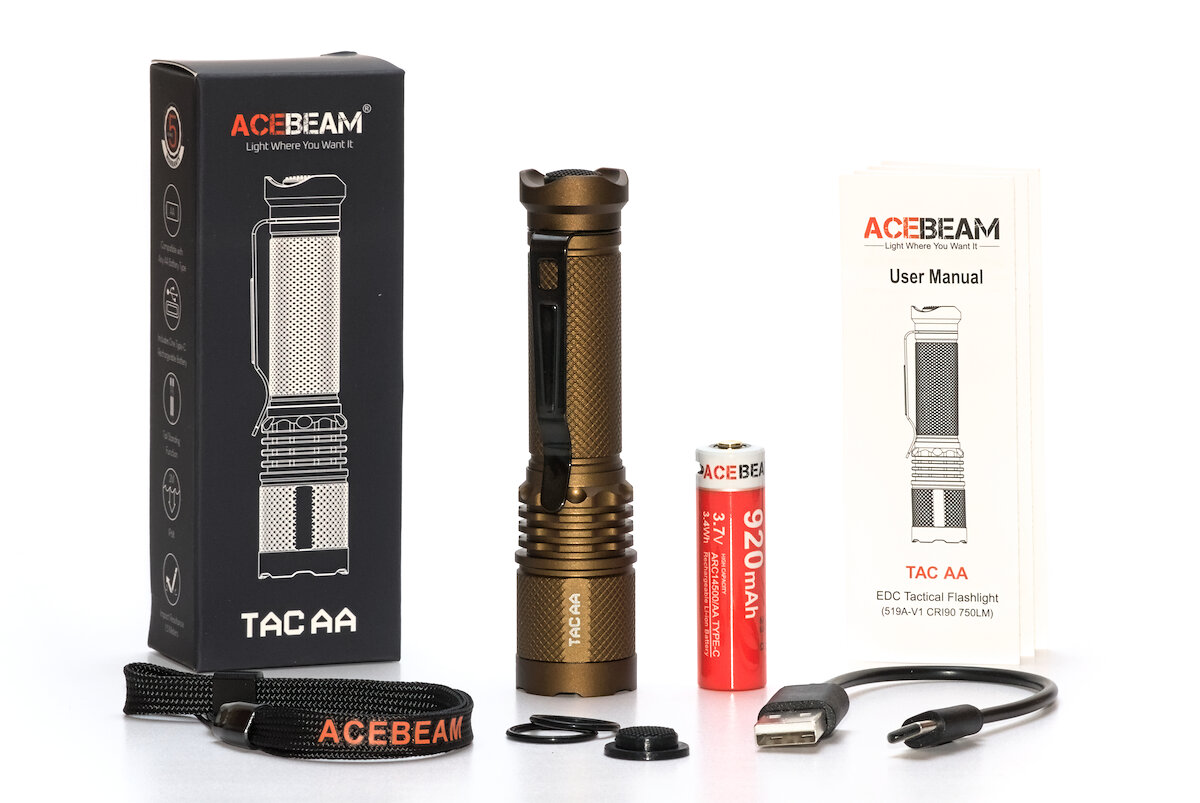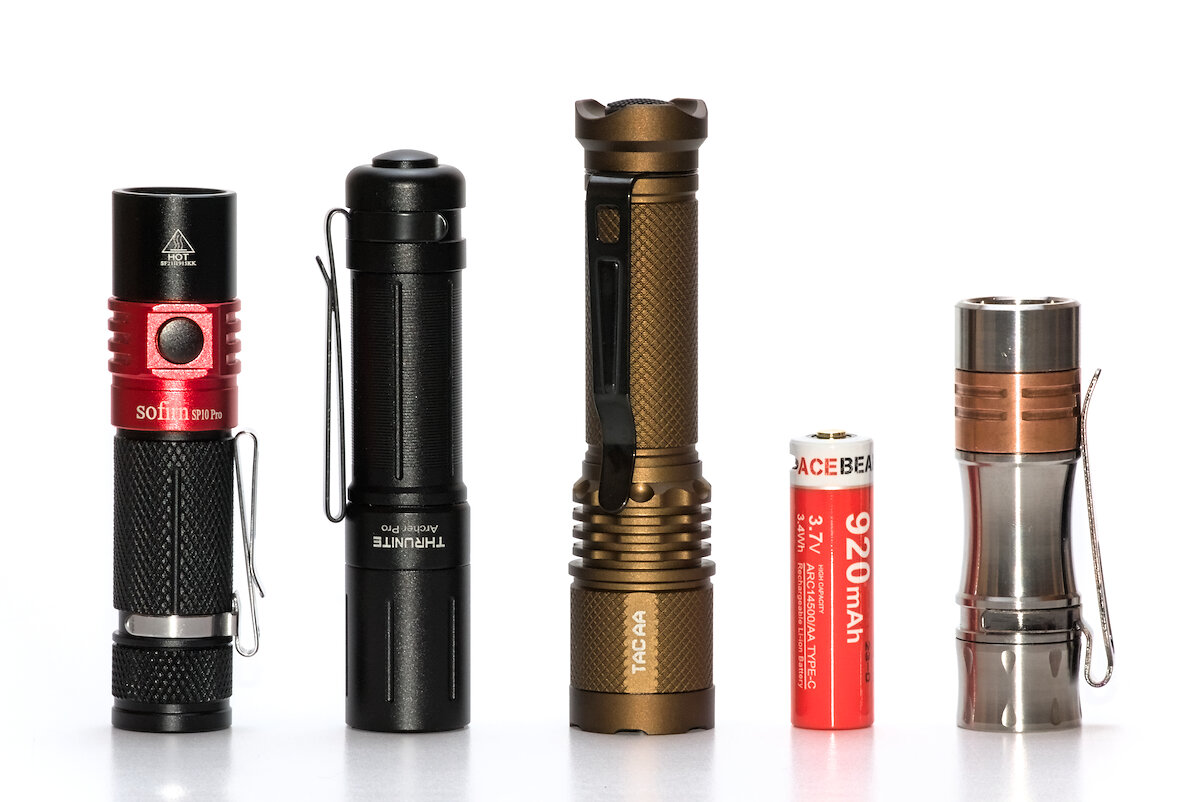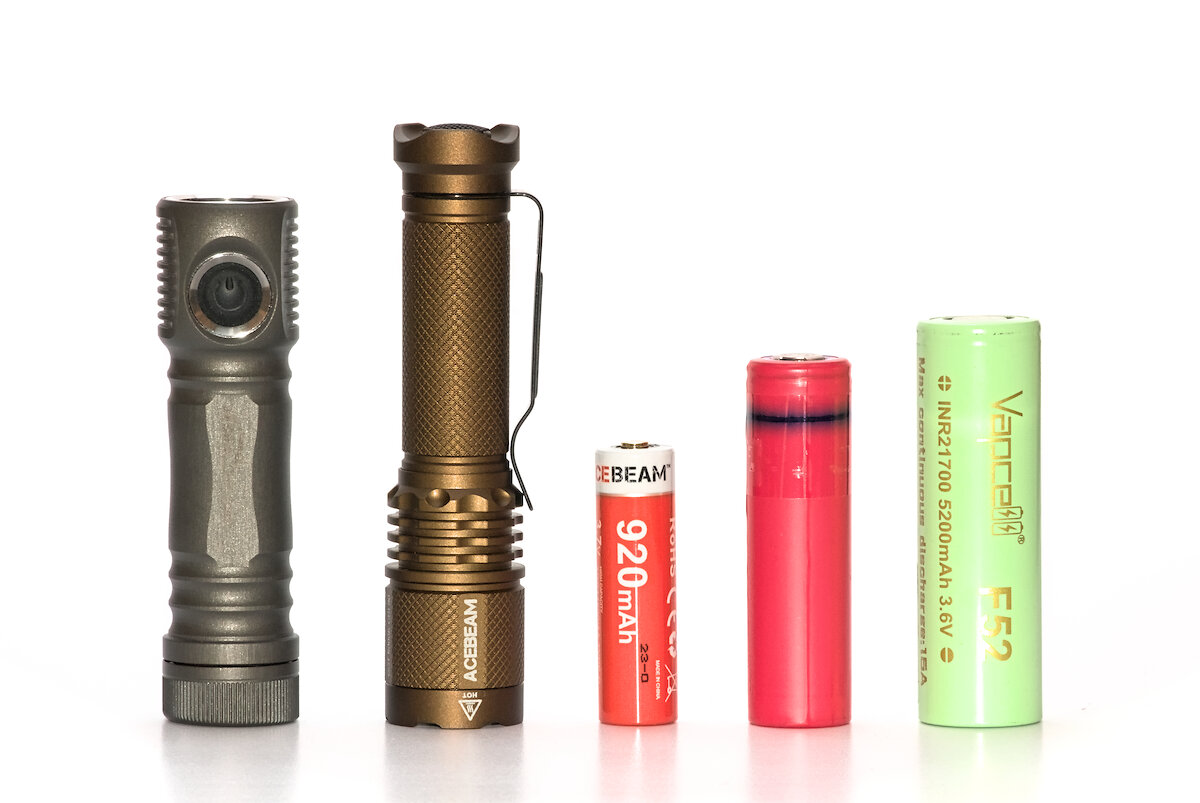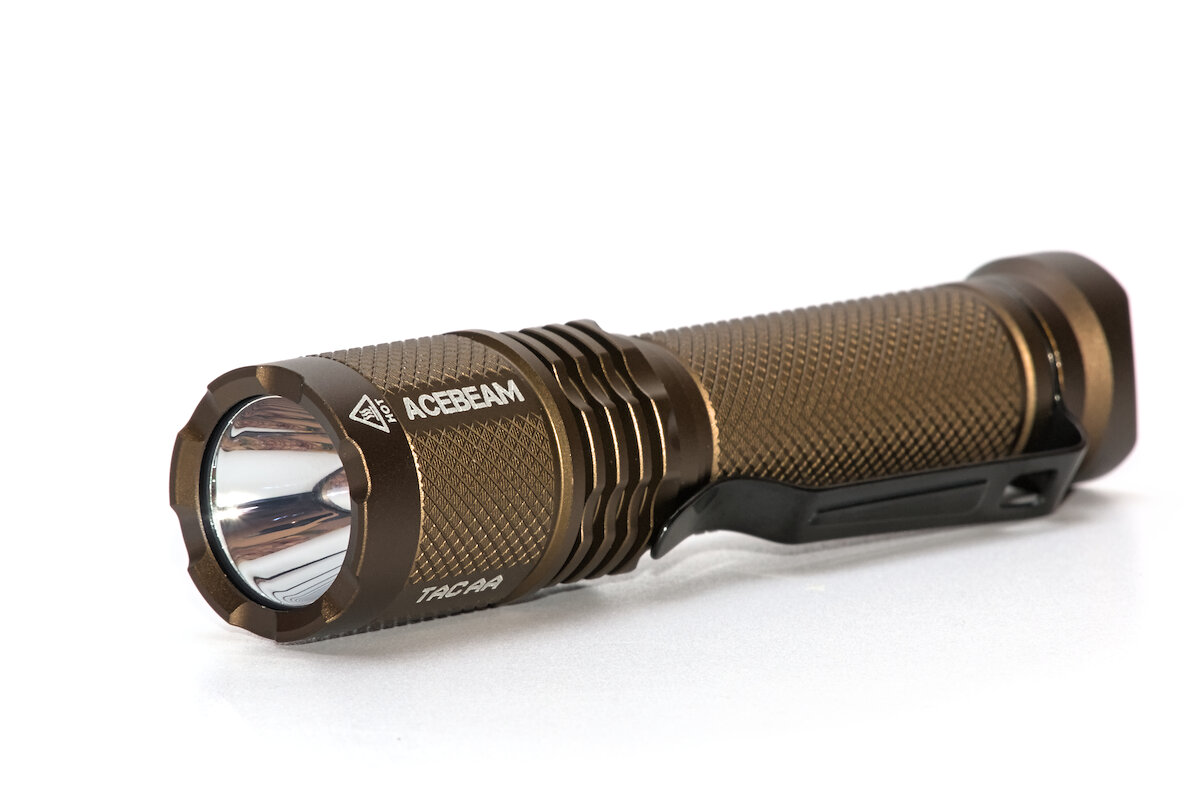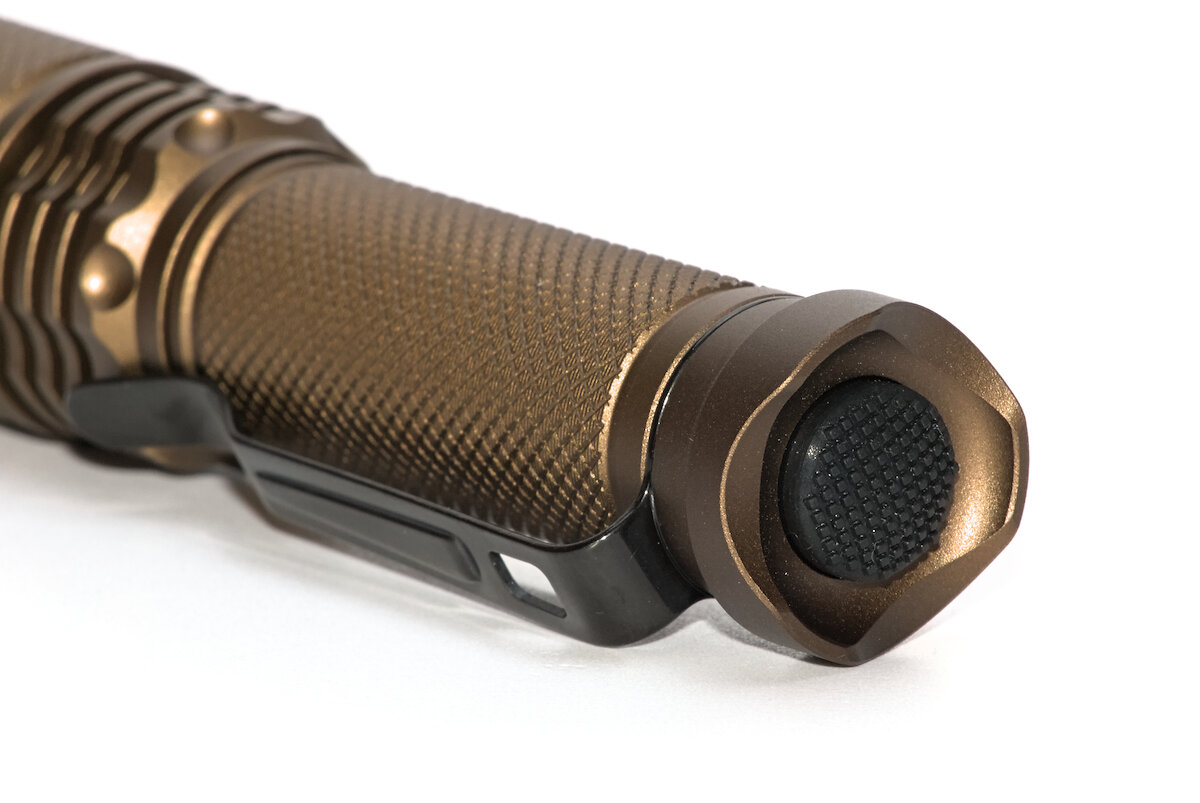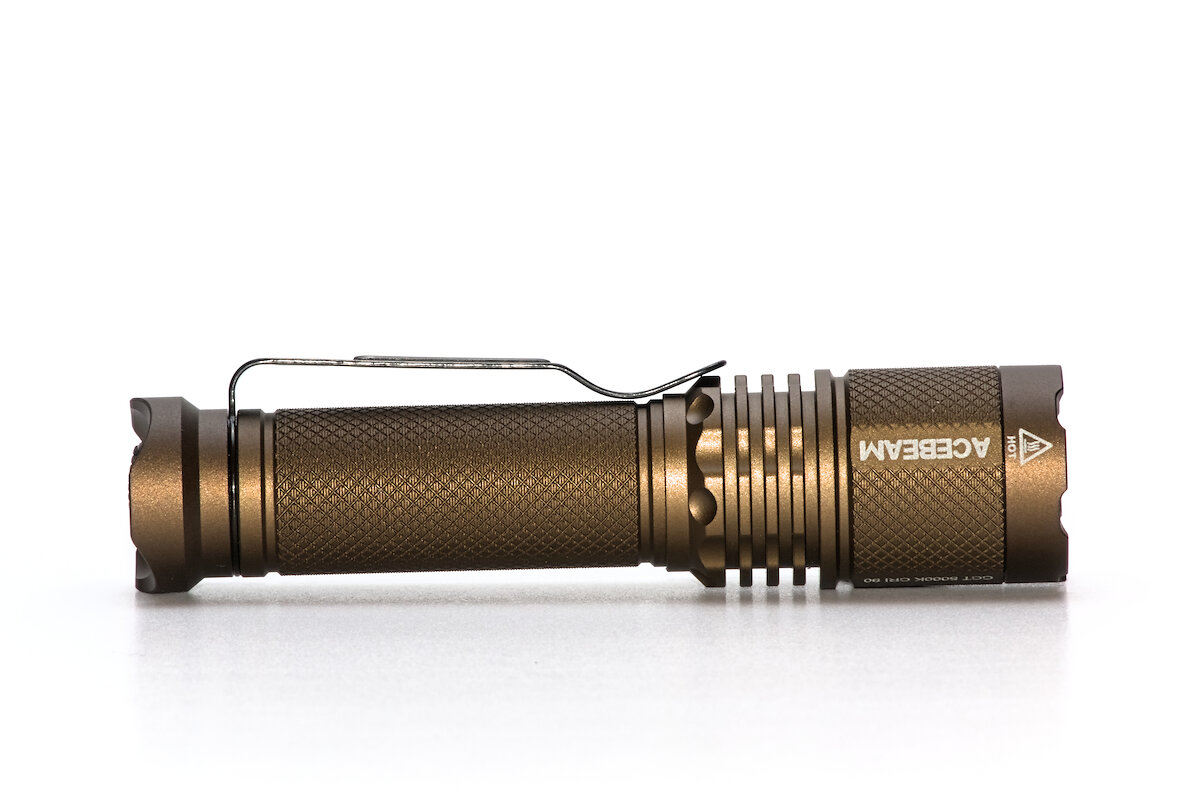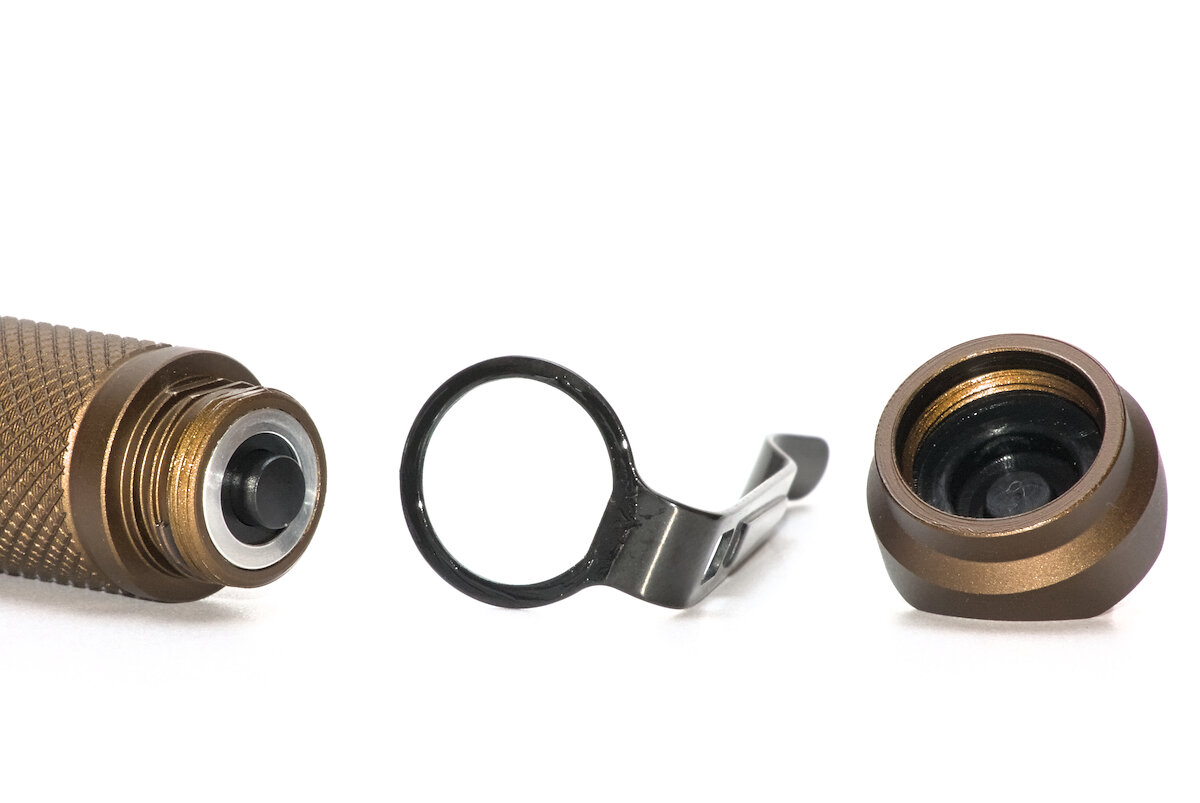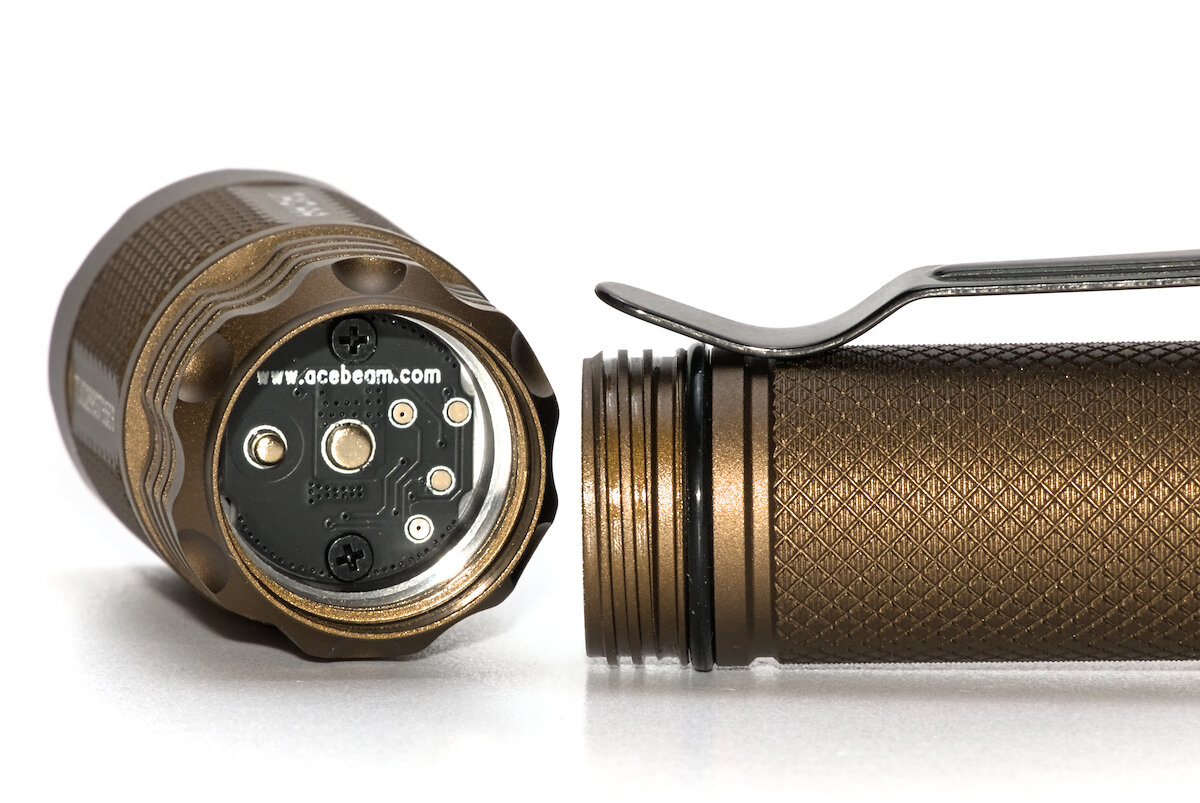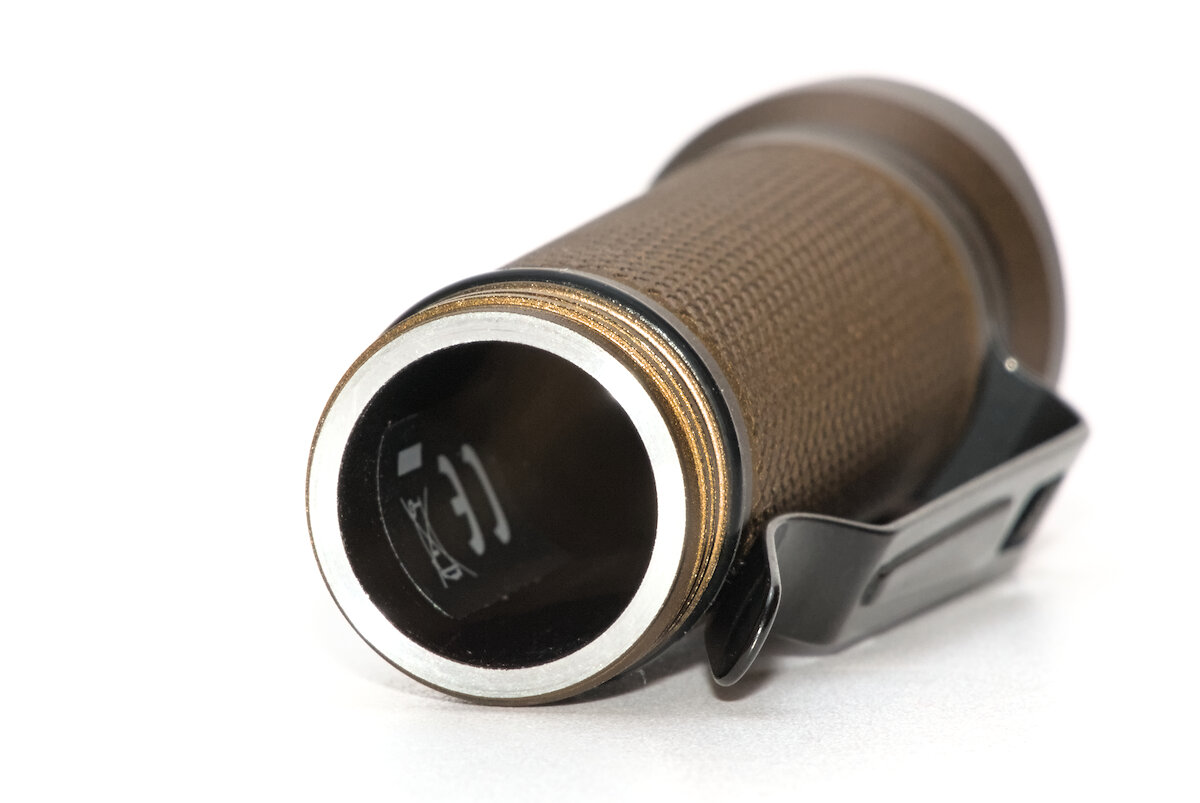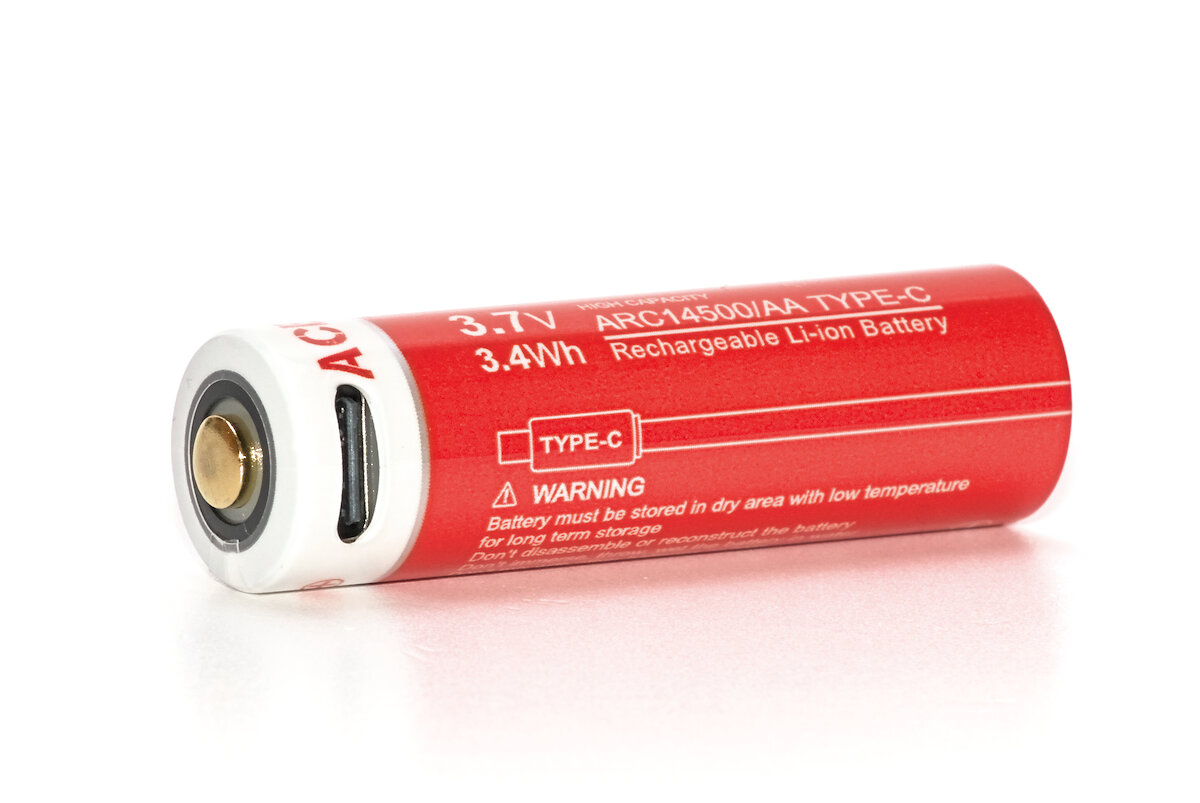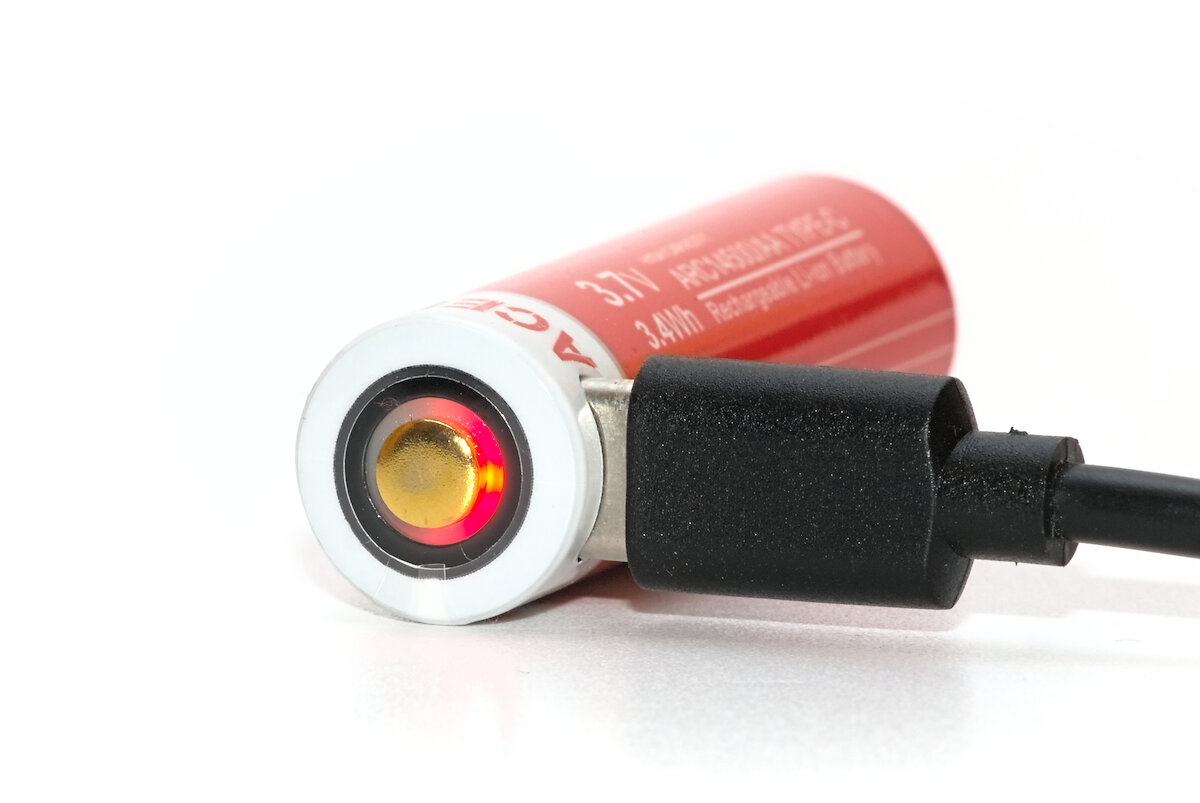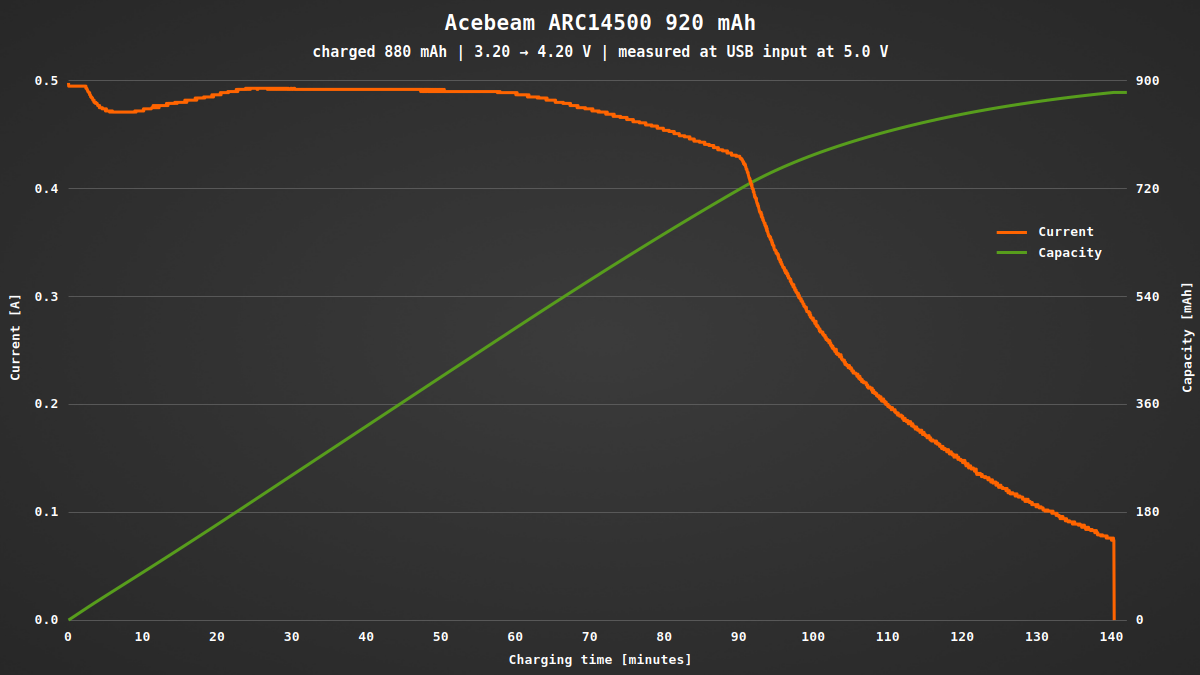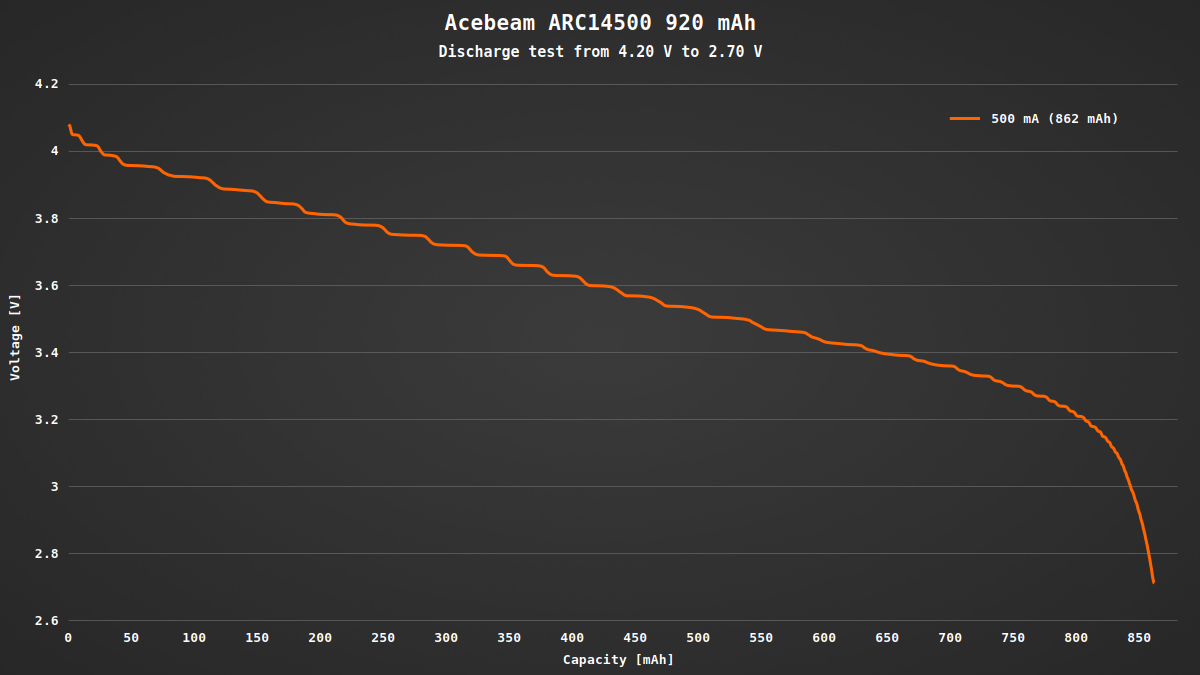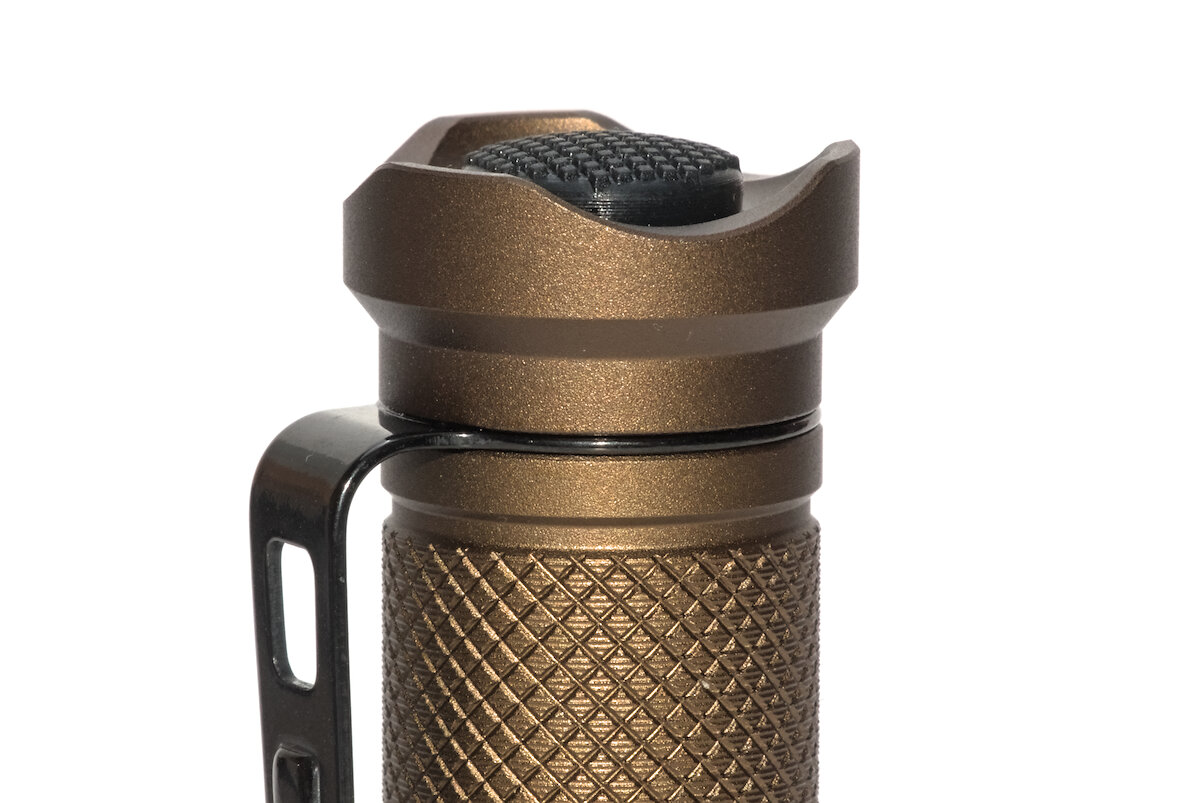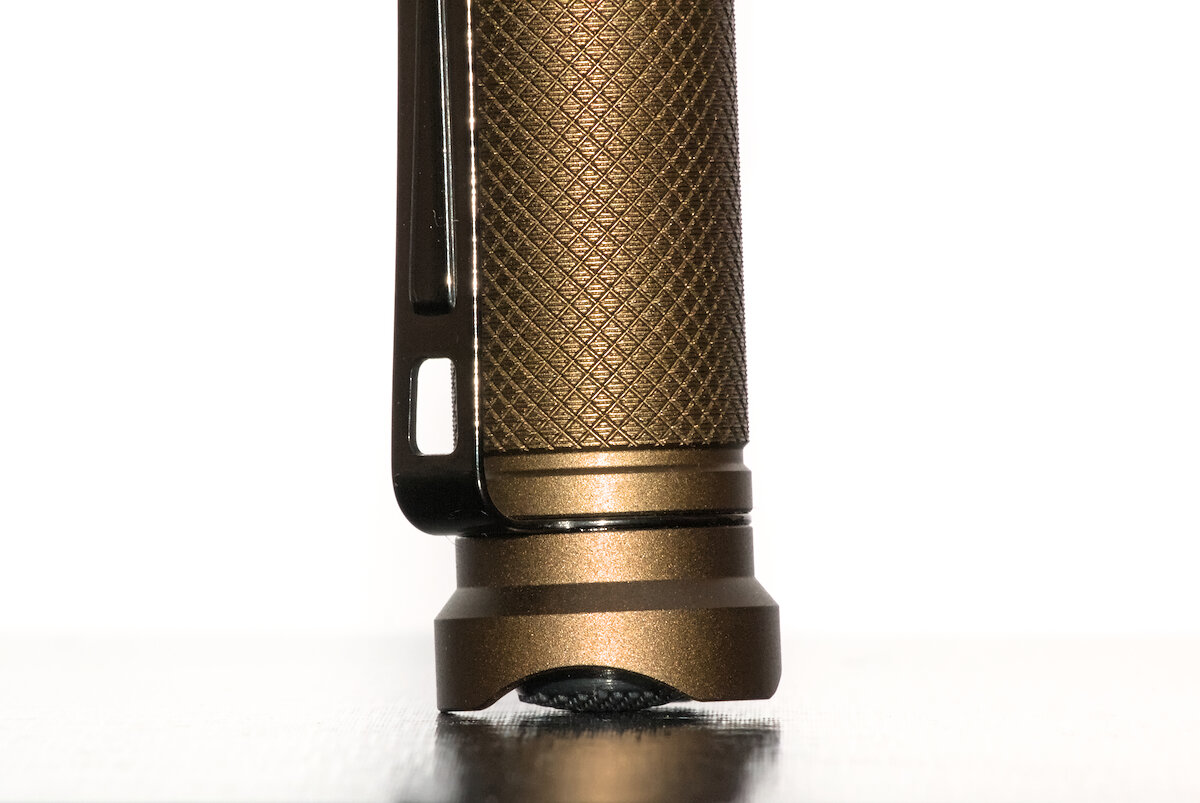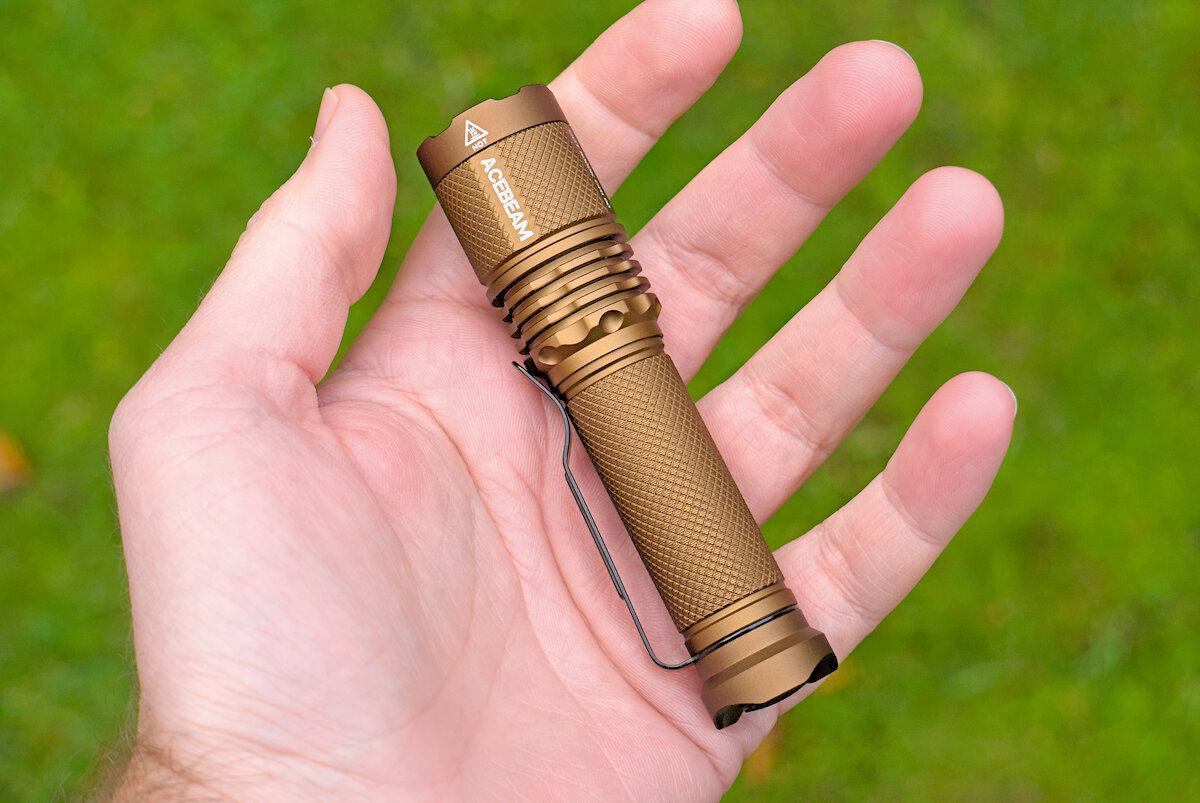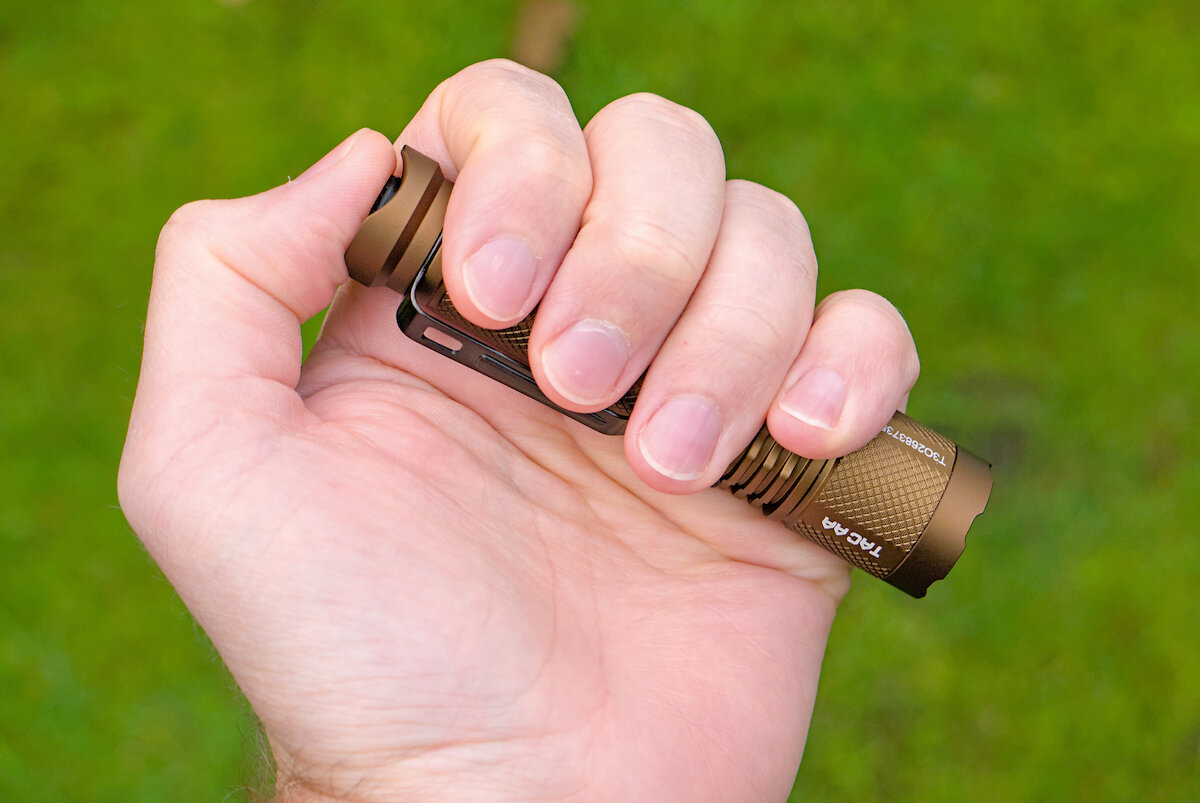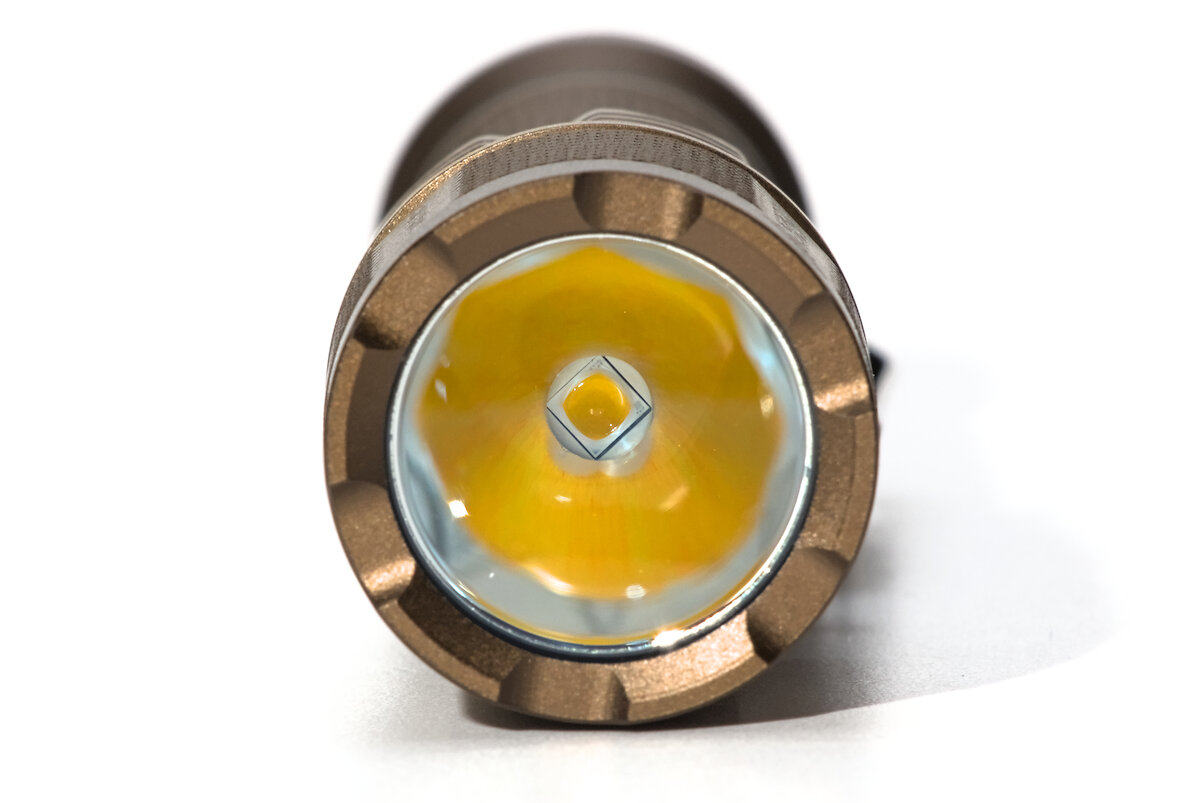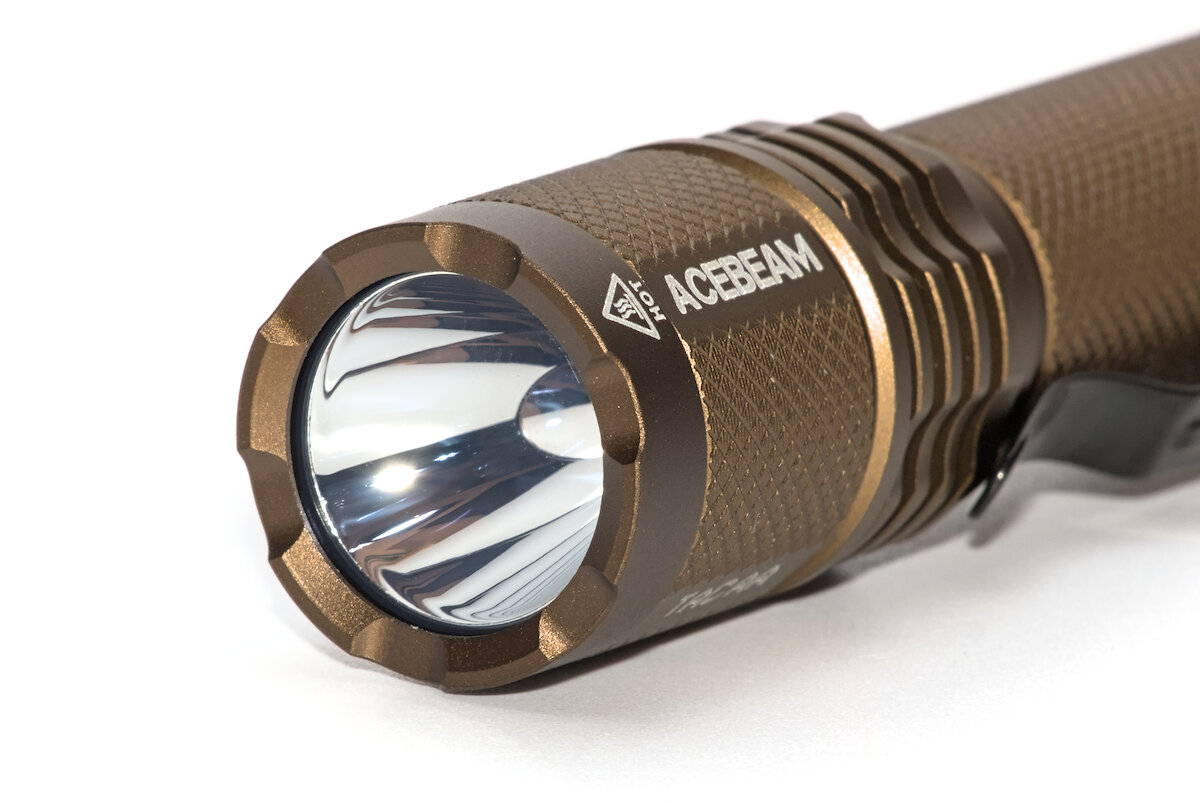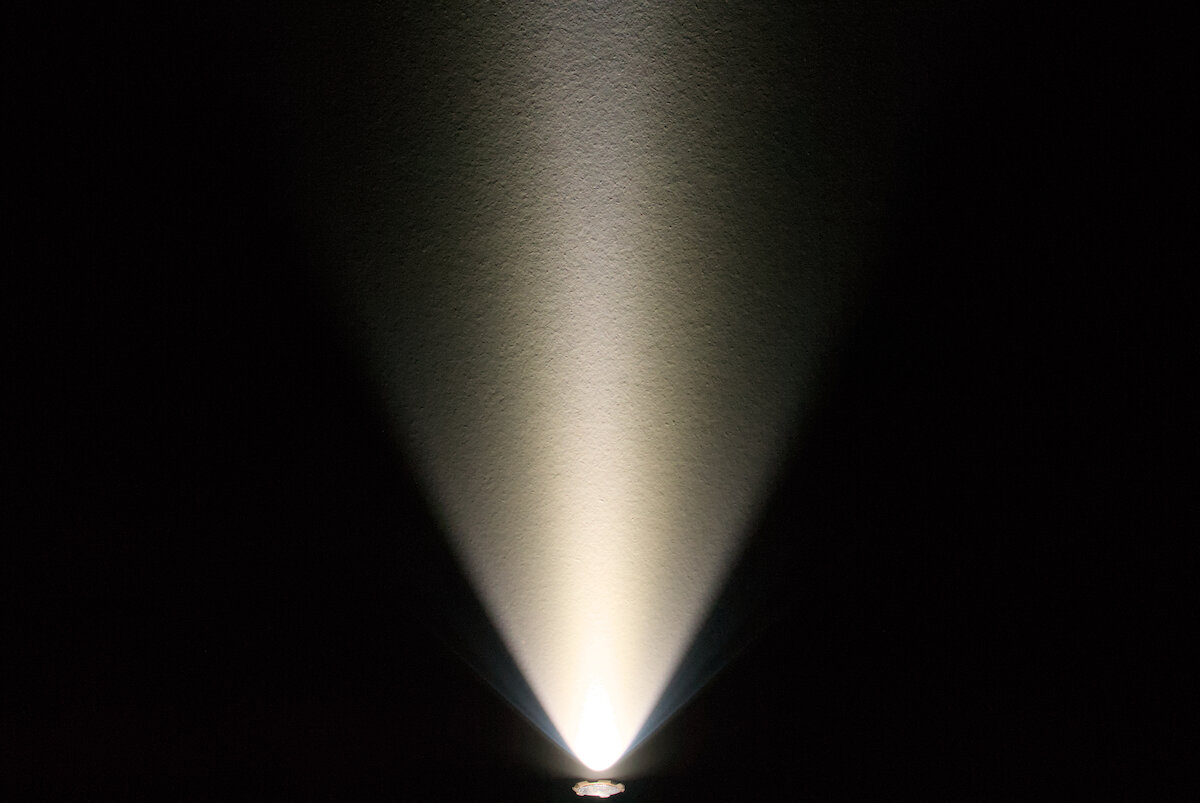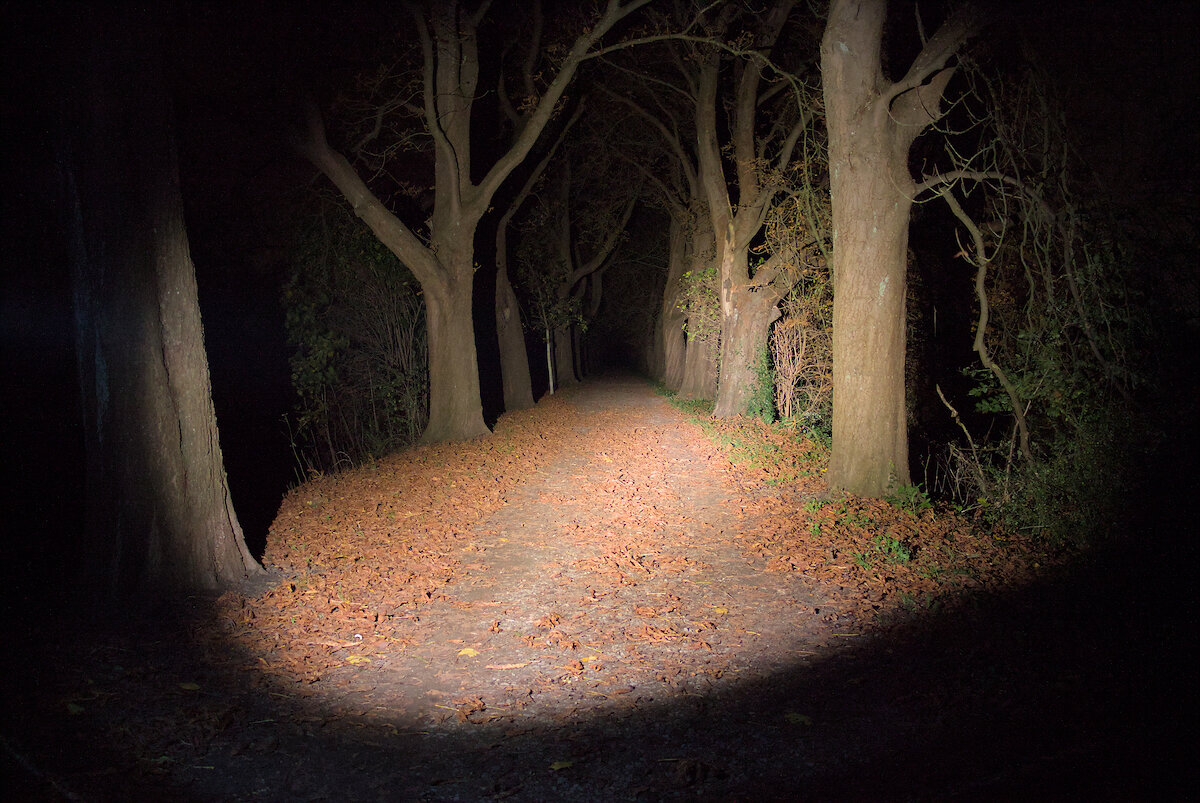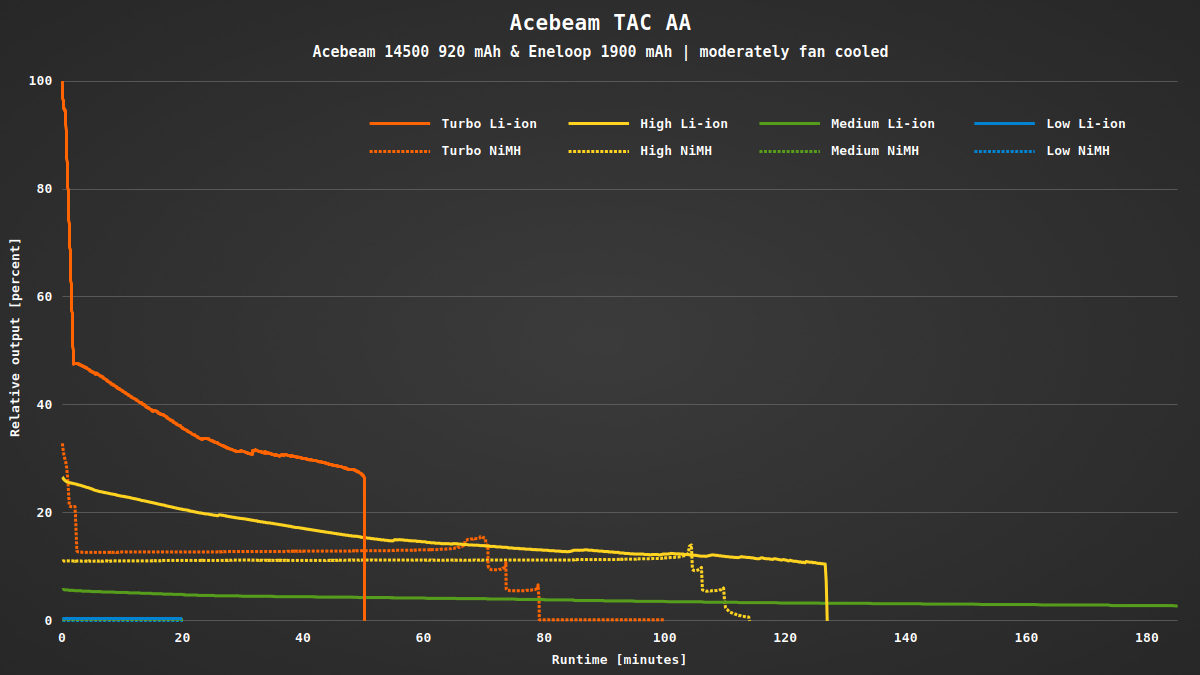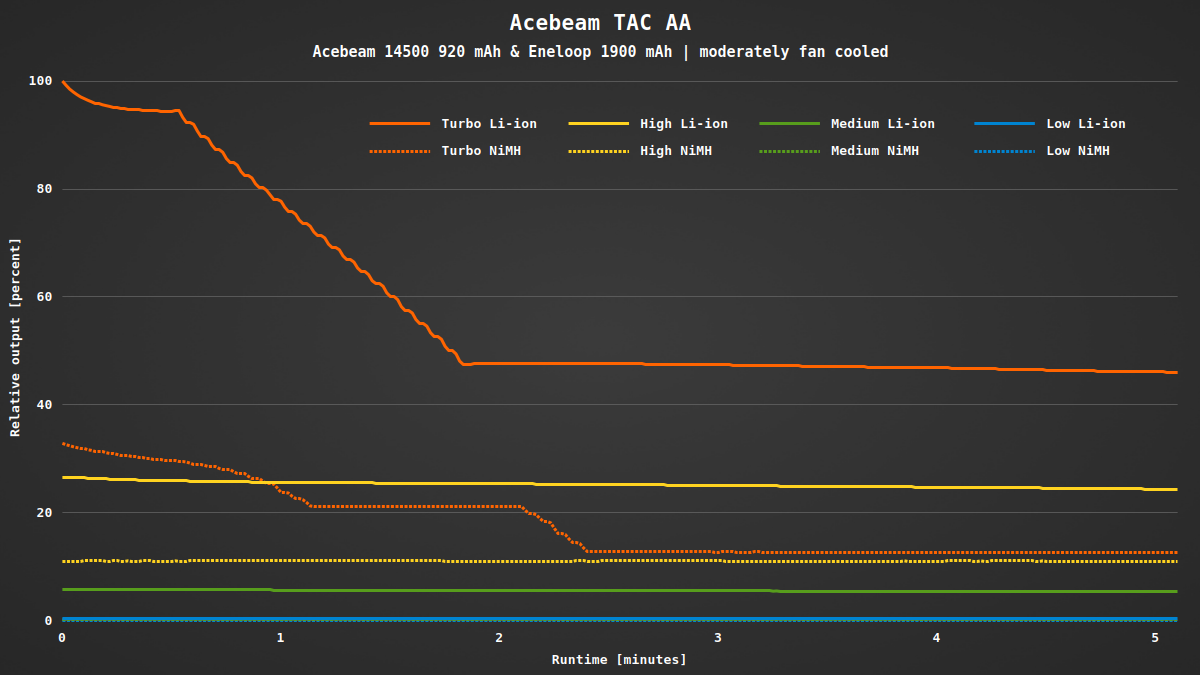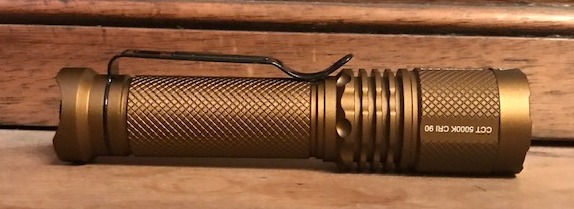What do you think when you hear “tactical flashlight”? Medium sized flashlight with 18650 or 21700 battery, direct access to turbo and strobe, very bright and good throw? Let me show you the Acebeam TAC AA, which is described as an “EDC Tactical Flashlight” by the manufacturer.
This review is also available in German on my website: SammysHP Blog › Acebeam TAC AA
This review was made possibly by flashlightgo from where I got this flashlight for free in return for this review. Thank you very much!
Supplied parts and hardware
- Acebeam “ARC14500” 14500 Li-ion battery with 920 mAh (3.92 V on delivery)
- Clip (mounted)
- USB-C charging cable
- Lanyard
- 2x replacement o-ring
- Replacement switch cover
- Manual (EN, CN)
At the time of writing the TAC AA was available in four colors and two LED variants, but not in all of their combinations:
| 6500 K | 5000 K | |
|---|---|---|
| Gray | ||
| Green | ||
| Black | ||
| Coyote |
You would expect something small from a AA or 14500 flashlight, right? The TAC AA isn’t small with its length of 105 mm and a diameter of 24.8 mm. It weights 54,4 g (including clip), the battery adds another 21 g. This makes it the largest of my flashlights with a single AA battery.
It is even larger as some 18650 flashlights, like the ZebraLight SC63 shown in the picture. But if you ignore the small battery for a moment, the TAC AA has a really nice size and good proportions.
Almost every part of the flashlight has some classic, diamond shaped knurling. This makes the flashlight really secure to grip. The crenelated “strike bezel” is meant to be used to break glass, although I doubt that it will work well and definitely cannot recommend it (you will hurt yourself). On the other hand it makes it possible to see if the light is turned on while standing on its head.
The tailcap of the flashlight includes the mechanical switch, that is protected by a rim with three cutouts to make it easier to press. A lanyard can only be attached to a hole in the clip.
The designer of the clip made a lot of things right. High capacity, large opening and it sits far back for almost deep carry. Unfortunately its opening is completely blocked by the head and makes it hard to use. You’ll have to open it a bit first before being able to clip it to your pocket.
Attachment of the clip is nice. It is well secured by the screwed-on tailcap and thus cannot get lost.
But if you want to remove the clip, it gets complicated. First unscrew the tailcap, but watch out – it is left-hand threaded! You have to turn it clockwise to unscrew (this will also happen by accident when you want to tighten the head after swapping the battery). Afterwards carefully remove the o-ring, then try to pull off the clip without jamming it in the threads. It is indexed, so it goes on only in one direction.
The head has coarse square threads. The clip slightly touches the head while turning it, which can scratch it.
While the tailcap has a spring, the head only comes with a flat contact. Next to it you’ll find a little pin which is the mechanical reverse polarity protection (yes, it is isolated). This means you can only use button-top batteries.
Apropos battery: Per specification the flashlight supports 3.6 V Li-ion batteries as well as 1.5 V NiMH batteries (or Alkaline batteries) of the size 14500/AA/Mignon. Actually every type of battery has one or another drawback, described later in the review.
How do you achieve a 19 mm diameter of the battery tube for a AA flashlight? By making the wall 2 mm thick. Acebeam states that it will survive drops of 1.5 m height. It is also IPX8 rated, which makes it waterproof up to two meters depth.
I really like the manufacturing quality. Everything is nicely chamfered or deburred and the anodization is perfect.
Acebeam ARC14500 battery
The TAC AA doesn’t have an integrated charging function. But the included 14500 battery comes with a USB-C charging port!
This is such a great battery that I dedicate it its own section of the review. With a length of 50.8 mm it fits perfectly in my Wurkkos TS10, which doesn’t have a charging function either. The battery has a weight of 21 g and a capacity of 920 mAh per specification. While charging an indicator LED at the positive pole lights up in red, afterwards in green.
The charging current is up to 500 mA, a good value for a battery of this capacity. Charging takes a little bit over two hours.
My discharge curve looks a little weird, because the resolution of my logger isn’t great. But it is enough to give a good approximation of the actual capacity. With 500 mA discharge current the capacity from 4.2 to 2.7 V was still 862 mAh – in my opinion a good result.
So far about the “ARC14500” battery, let’s continue with the TAC AA flashlight.
User interface and features
The flashlight is controlled via a mechanical tail switch. It is a forward clicky, which means that you can hold it for momentary light and it will only stay on when you press it in completely.
The rim protects the switch from accidental activation. Three cutouts make the switch easier to press. You need some force to press the switch, so that an accidental activation is even less likely. If you want even more protection, mechanical lockout by loosening the head is possible.
Unfortunately the switch cover protrudes a little bit too far so that the flashlight cannot tailstand reliably, although it is explicitly mentioned in the manual (“Tail stand capable for area wide lighting”). It might work sometimes if the light is turned on.
The UI is very simple: Tap the button one or more times until you have reached the desired brightness (low → medium → high → turbo), then press it completely until it clicks. Or in other words: Switching the light off for a short time and on again advances the mode. If the light is turned off for at least three seconds, it will remember the previous brightness. Because of this it is not possible to use it for signaling/blinking.
There are no other modes, no strobe, no SOS. This makes it even less tactical, especially without a shortcut to turbo. On the other hand it is absolutely enough for a regular EDC flashlight – and that’s what the TAC AA is in my opinion (although it comes with a slight tactical flair).
Thanks to the location of the tail switch it is easy to locate. Just make sure that it is turned off for three seconds between activation or it will change the brightness. Too bad that you can’t use it for blinking – that’s the advantage of a forward clicky.
The rim on the tailcap is thick enough to use it as a tactical ring. This allows you to hold the flashlight in a “cigar grip”.
Illumination
You can choose between two LED variants:
- Cool white (6500 K): Unknown LED, low CRI, but 1000 lm maximum brightness.
- Neutral white (5000 K): Nichia 519A, high CRI, very nice tint. Brightness only 750 lm, but in practice it doesn’t feel like a big difference compared to 1000 lm.
My recommendation is the Nichia 519A, without doubt. Much better color rendition, especially red colors. In this review I also use this version.
The beam is shaped by a smooth, deep reflector. The manual states that it it protected by a polycarbonate lens, but it feels more like glass. I’m not sure if it has an anti-reflective coating. Maybe a little bit, but I couldn’t really notice it.
The spot is surrounded by a large and soft corona. Because of the deep reflector the spill is rather tight, but still usable. There are some smaller rings around the spill, but they are so dark that they are barely noticeable.
It is a nice universal beam, suitable for out- and inside. Just as I like it for an EDC flashlight.
Driver and runtime
Well, so far so good. Unfortunately I am rather disappointed by the driver.
The specifications (only shown for the 519A variant here) look good:
| Mode | Brightness¹ | Runtime¹ | Intensity¹ (Throw²) |
|---|---|---|---|
| Turbo | 750/400 lm | 35 s + 49 min | 10 000 cd (200 m) |
| High | 200 lm | 2 h | |
| Medium | 40 lm | 14 h | |
| Low | 5 lm | 58 h |
¹ According to manufacturer ² ANSI FL1
But they apply only to a Li-ion battery. Acebeam doesn’t mention anything about the performance with NiMH batteries. In my runtime measurements I noticed this:
- When using Li-ion batteries, the brightness decreases, matching the battery voltage. This doesn’t look like a constant current driver, something I’d have expected from a manufacturer like Acebeam.
- With NiMH batteries the mode order is messed up. Instead of low → medium → high → turbo it is now low → ultra-low → high → turbo. No medium whatsoever. This was confirmed by other users and even by Acebeam.
With both types of batteries the brightness in turbo will be reduced after 35 s. During this time the flashlight warms up to only 35 °C.
I have stopped the measurement of low levels early because they were so dark that my meter couldn’t get a good reading.
When I measured the light output with my oscilloscope, I noticed that all levels (even turbo) with all types of battery use PWM at 20 kHz. Looks like the LED is direct-driven by a FET and the boost regulator for the NiMH battery just boosts the voltage to a Li-Ion level. Maybe Acebeam has experienced that full power is too much for the 519A and therefore has used PWM even for turbo.
The manual mentions that there is a low battery warning (“Low battery voltage warning alerts you to charging or replacing battery”), but I couldn’t see it in any way. At the end the flashlight just turns off (at around 2.7 V with Li-ion and 0.9 V with NiMH). So far I wasn’t able to do proper current measurements because I had problems getting a good connection without the battery tube (which is closed at its rear end).
Conclusion
As long as you ignore the term “tactical” in the product description, the Acebeam TAC AA is a nice EDC flashlight. On the larger side for a AA flashlight, but just the right size for a comfortable grip. The Nichia 519A with its lovely tint and high CRI will make you happy. The universal beam is great for EDC use and comes with good throw for a light of this size. Build quality is superb and it feels very robust.
Unfortunately the driver is on a different level: Simple brightness regulation using PWM and the modes are messed up when using a NiMH battery. A real shame, because the TAC AA would have been a very nice, simple AA flashlight for family and friends. I wonder why Acebeam didn’t use a better driver.
Overall the Acebeam TAC AA struggles to stand out against other less expensive flashlights. Yet it is a good option if you need support for Li-ion and NiMH batteries, as long as you don’t miss the medium mode with NiMH. There aren’t many other candidates with similar features.
Got curious? Acebeam TAC AA at flashlightgo.
